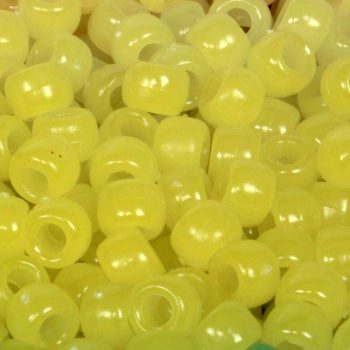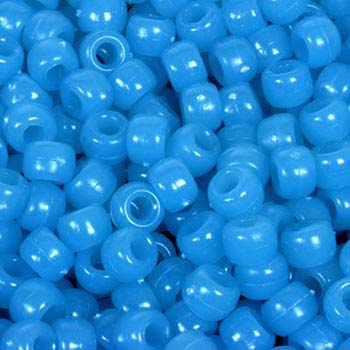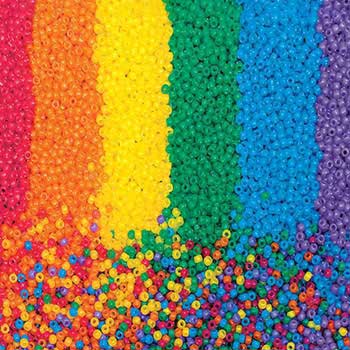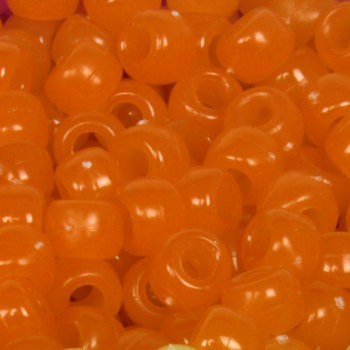Description
 Watch white beads change to red when taken outside the building! When returned they turn back to white. What causes the change? Humidity? Temperature? Fresh air? Birds flying overhead? The beads contain pigments which react with ultraviolet light from the sun, even on a cloudy day. They also change with most classroom UV light sources. Students can make their own UV light detecting bracelet by stringing the beads on a pipe stem or on a strip of rawhide. Great for teaching UV awareness! Use the beads to test the UV blocking effectiveness of sunblock, sunglasses, windows, etc. Lesson activities are included. The ultraviolet beads will cycle back and forth (to red and back again) over 50,000 times! Approximately 250 beads per package. All of our UV beads are the same size. Approximate bead dimensions:
Watch white beads change to red when taken outside the building! When returned they turn back to white. What causes the change? Humidity? Temperature? Fresh air? Birds flying overhead? The beads contain pigments which react with ultraviolet light from the sun, even on a cloudy day. They also change with most classroom UV light sources. Students can make their own UV light detecting bracelet by stringing the beads on a pipe stem or on a strip of rawhide. Great for teaching UV awareness! Use the beads to test the UV blocking effectiveness of sunblock, sunglasses, windows, etc. Lesson activities are included. The ultraviolet beads will cycle back and forth (to red and back again) over 50,000 times! Approximately 250 beads per package. All of our UV beads are the same size. Approximate bead dimensions: diameter 8.5 mm (5/16") - center hole 3.6 mm (9/64")
 Read more on our Blog - Chemistry of Ultraviolet Detecting Beads with Video
Read more on our Blog - Chemistry of Ultraviolet Detecting Beads with Video  Read more on our Blog - UV Radiation Activity
Read more on our Blog - UV Radiation Activity 
Video
Lesson Ideas
Reviews




 Feb 13, 2018
Feb 13, 2018
Was this review helpful?




 May 2, 2016
May 2, 2016
Was this review helpful?




 Dec 25, 2013
Dec 25, 2013
Was this review helpful?
NGSS
This product will support your students' understanding of the Next Generation Science Standards (NGSS)*, as shown in the table below.| Elementary | Middle School | High School | ||
| 1-PS4-2 Students can conduct investigations showing evidence of illumination from an external source such as the Sun. 1-PS4-4Electromagnetic Radiation Objects can be seen only when light is available to illuminate them. | MS-PS4-1 Students can conduct investigations showing evidence that the amplitude of a wave is related to the energy in the wave. MS-PS4-2Students can use this tool to develop and use a model to describe how waves are reflected, absorbed, or transmitted through various materials. | HS-PS4-5 Students can use UV Beads to conduct investigations on how technological devices use the principles of wave behavior and wave interactions with matter to transmit and capture energy. HS-PS4-3Students can use the UV Beads to evaluate the claims, evidence, and reasoning behind the idea that electromagnetic radiation can be described by a wave model. HS-PS4-4Students can explore the idea that different frequencies of light have different energies, and the damage to living tissue from electromagnetic radiation depends on the energy of the radiation. |
UV light detectors can be made with these beads. Worn as a bracelet or zip pull, the beads will help students develop awareness of where and when UV light is present.
PS4.BObjects can be seen only when light is available to illuminate them.
MS-PS4-1Students can conduct investigations outside with the Outside Detector and make correlations to the Electromagnetic Spectrum and the amplitude of a wave is related to the energy in a wave.
MS-PS4-2Students can use the beads to test different materials to see if the UV waves are being reflected, absorbed, or transmitted through various materials. Colored beads indicate that waves are transmitted.
HS-PS4-5Students can use these UV Beads in experiments to support mathematical representations of UV light versus white light.
* NGSS is a registered trademark of Achieve. Neither Achieve nor the lead states and partners that developed the Next Generation Science Standards were involved in the production of, and do not endorse, this product.
You May Also Like
-
$6.95











